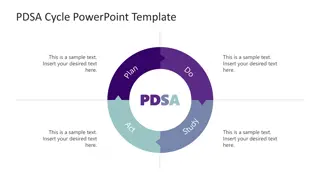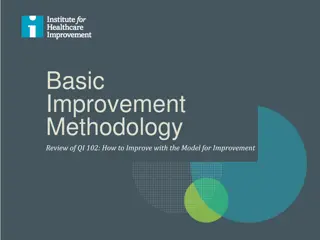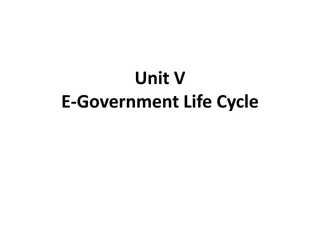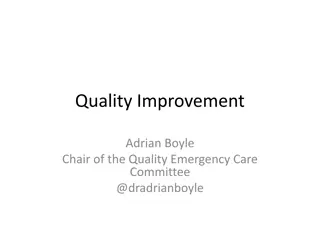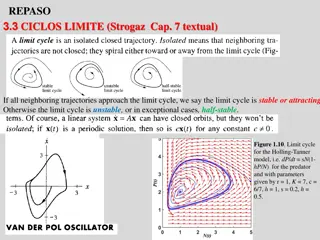The Model for Improvement and PDSA Cycles in Quality Care
The Model for Improvement framework introduces PDSA cycles as a method for testing changes in practice to determine if they lead to improvement before full implementation. PDSAs focus on translating ideas into action and conducting small tests of change iteratively. Testing changes before implementation builds evidence, increases confidence, and helps identify improvements in real work settings across various conditions.
Download Presentation

Please find below an Image/Link to download the presentation.
The content on the website is provided AS IS for your information and personal use only. It may not be sold, licensed, or shared on other websites without obtaining consent from the author.If you encounter any issues during the download, it is possible that the publisher has removed the file from their server.
You are allowed to download the files provided on this website for personal or commercial use, subject to the condition that they are used lawfully. All files are the property of their respective owners.
The content on the website is provided AS IS for your information and personal use only. It may not be sold, licensed, or shared on other websites without obtaining consent from the author.
E N D
Presentation Transcript
What is Quality Care
The Model For Improvement PDSA s are part of the framework for improvement Aim Measurement Change ideas Testing of change ideas in practice to determine if the change results in Improvement The Improvement Guide Langley J et al 2009
Before you start your PDSA The improvement team will have answered the 3 questions of the Model For Improvement Question 1. What are you trying to accomplish- Aim Question 2. What changes will you make that will result in improvement-Change ideas Question 3 . How will you know the change has led to improvement-Measurement
The Model for Improvement introduces us to the principle of testing out changes while monitoring outcome and process measures to determine if the changes are leading to an improvement before being implemented in practice. Testing also allows the necessary modifications to the original idea before it is made permanent. (Green et al. 2019, p.14)
PDSAs take your change idea and tests it in practice to see if it leads to improvement before it is implemented in practice Reed and Card (2016) state that PDSA s focus on the: Crux of change helping to translate ideas and intentions into action.
Why Test a change in practice prior to implementation Build evidence about whether it is an improvement- it increases confidence and knowledge about the change Run a small experiment to try out a new idea at the same time as doing what you normally do- Its less disruptive You don t have to convince lots of people that your idea is a good one- start working with the willing Can get rid of teething problems before implementation You can check that the change works under different conditions Other people can learn from it and are more likely to try it Can check if it works as well for us as it did for others
PDSA cycles consists of: Iterative testing Small tests of change Carried out in rapid cycles Real work settings To learn which changes in which contexts produce improvement Several PDSA s are linked sequentially Tested under a variety of conditions in real work settings Rapid cycles allow for evaluation to determine if a change is an improvement PDSA is not a one-time event Each cycle builds on the current knowledge about the changes you are trying Ramps of increasing scale
PDSA- Sequential building of knowledge For one change idea, we would expect to go through a series of PDSA cycles before we are ready for implementation. This is called a ramp of PDSA cycles. Each change idea will have its own ramp. Some may never reach implementation, if you learn that this change doesn t lead to the improvement you are looking for.
Testing changes in Practice This is where the PDSA cycle portion of the Model for Improvement comes in. 1. 2. 3. 4. 5. Planning a test of change, -Plan Trying the plan, -Do Observing the results, -Study Acting on what you learn, -Act Progressively move toward your aim.
Planning phase of a PDSA Provost and Murray (2011) recommend the following actions as part of the planning stage: Agree the objective of the PDSA cycle Define specific questions to be answered in the cycle These questions describe the teams predictions about the changes that will be tested The predictions should be worded in such a way that the results of the tests conducted in the cycle can be compared to the predictions The basics: Who will schedule and conduct the test? Exactly what changes will be made? Where will the test be conducted? When will the test be done? What data will be collected to answer the questions in the cycle?
Measurement during PDSA cycles Why- All improvement will require change, but not all change will result in improvement One of the questions of the Model For Improvement- How will you know the change is an improvement? What information is important to collect? Why is it important? Who will collect the data? Who will analyze the data prior to Study ? Where will data be collected? When will data collection take place? How will the data (measures or observations) be collected? Scottish Improvement Skills
Do Phase of the PDSA cycle The Do phase Test is performed Problems are documented Observe for new ideas Collect data
Study phase of the PDSA cycle The Study Phase/Evaluation Asking what happened when you ran the test Were you able to run the test Analyse data both quantitative and qualitative Was there an improvement in the outcome measure when you ran the test Compare the findings to your predictions Was there any negative consequences with running the test Summarise what you learnt
Act phase of the PDSA cycle Taking action based on new knowledge in the act phase (Provost and Murray 2011, p.8). Does the change need to be modified slightly to get it to work better, if so adapt and run the test again on a small scale If the change worked well, increase the scale and test again Then test under a range of different conditions to check if the change still leads to improvement If the change showed no improvement at all, you may decide to abandon the it and test another change 3 A s- Adapt, Adopt, Abandon.
Challenges to using PDSA Reed and Card (2016) cited one of the main problems encountered in using PDSA is the: misperception that it is simple to apply and that it can be used as a standalone method . Successful PDSA process does not equal a successful quality improvement process or project. In complex systems, the process of change rarely progresses in simple linear ramps.


